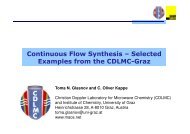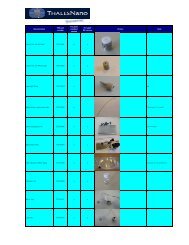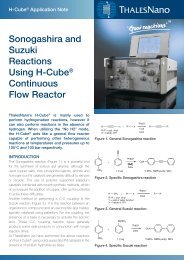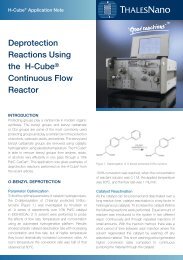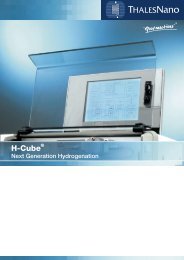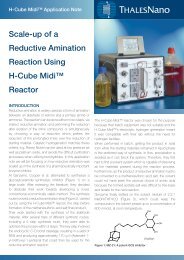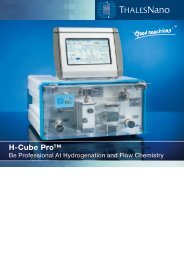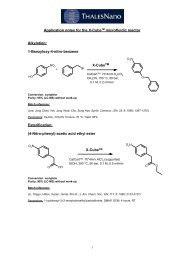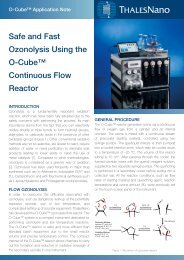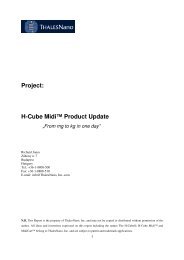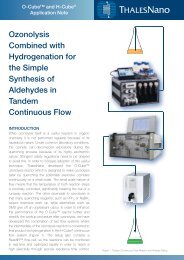Deuteration Reactions Using the H-Cube ... - ThalesNano
Deuteration Reactions Using the H-Cube ... - ThalesNano
Deuteration Reactions Using the H-Cube ... - ThalesNano
You also want an ePaper? Increase the reach of your titles
YUMPU automatically turns print PDFs into web optimized ePapers that Google loves.
H-<strong>Cube</strong> ® Application Note<br />
<strong>Deuteration</strong><br />
<strong>Reactions</strong> <strong>Using</strong> <strong>the</strong><br />
H-<strong>Cube</strong> ®<br />
Continuous Flow<br />
Reactor<br />
INTRODUCTION<br />
Deuterium-labeled compounds are widely used as<br />
research tools in chemistry. Their importance lies in a<br />
number of applications, such as:<br />
• proving reaction mechanisms<br />
• investigation of a compound’s pharmacokinetic properties<br />
• internal standards in mass spectrometry<br />
• compound structure determination in NMR spectroscopy.<br />
Conventional techniques for <strong>the</strong> syn<strong>the</strong>sis of deuterated<br />
compounds utilize D 2 gas as a deuterium source.<br />
However, <strong>the</strong>re are drawbacks to utilizing deuterium gas<br />
on a laboratory scale, such as <strong>the</strong> handling of <strong>the</strong> gas<br />
itself. O<strong>the</strong>r methods have been employed to overcome<br />
this difficulty such as catalytic H–D exchange reactions<br />
between H 2 and D 2 O. However, <strong>the</strong>se methods are time<br />
consuming and do not produce high purity D 2 and <strong>the</strong>y<br />
also require high pressure, <strong>the</strong> use of a special catalyst,<br />
or an excess amount of a strong base or acid 1 .<br />
The H-<strong>Cube</strong> ® continuous flow system is capable of<br />
generating deuterium gas from <strong>the</strong> electrolysis of D 2 O,<br />
which is readily available in 99.98% purity and is easy to<br />
handle.<br />
TECHNIQUE<br />
High purity deuterated compounds can be generated in<br />
high yield as long as a few guidelines are followed. The<br />
first step is to remove <strong>the</strong> H 2 O from <strong>the</strong> water tank. This is<br />
easier to perform if your system is made of stainless steel<br />
with <strong>the</strong> “Purge Water” function on <strong>the</strong> Service screen.<br />
Step1: Drain <strong>the</strong> water from <strong>the</strong> reservoir using a<br />
syringe.<br />
Step 2: Remove <strong>the</strong> back of <strong>the</strong> water reservoir with <strong>the</strong><br />
supplied Allen wrench. Clean and dry <strong>the</strong> insides with a<br />
paper towel.<br />
Step 3: Go to <strong>the</strong> Service screen. Press <strong>the</strong> “Purge<br />
Water” function and press Stop after 10 seconds.<br />
Step 4: Replace <strong>the</strong> back of <strong>the</strong> water reservoir. Add<br />
30 mL of deuterated water. Press “Purge Water” for 10<br />
seconds.<br />
Step 5: Remove <strong>the</strong> back of <strong>the</strong> water reservoir, dry <strong>the</strong><br />
inside again, and press “Purge Water” for 10 seconds<br />
again.<br />
Step 6: Replace water reservoir back and fill with<br />
deuterated water. Press “Purge Water” to refill cell with<br />
D 2 O.<br />
Step 7: Take a blank CatCart® (titanium) and pass <strong>the</strong><br />
reaction solvent and run <strong>the</strong> system at Full H2 mode for<br />
20 minutes. Remove blank cartridge.<br />
RECOMMENDATIONS<br />
• Only use an aprotic solvent to avoid H–D exchange.<br />
• Do not use hydrogen saturated catalysts such as,<br />
Raney catalysts for <strong>the</strong> reaction.
There are two literature examples of where <strong>the</strong> H-<strong>Cube</strong> ®<br />
has been utilized for <strong>the</strong> deuteration of compounds.<br />
Fülöp et al. performed deuterations on a series of<br />
unsaturated compounds 1 . Optimum conditions were first<br />
explored using cinnamic acid as a standard.<br />
Early reactions using methanol and 10% Pd/C led to<br />
only a 30% incorporation of deuterium into <strong>the</strong> molecule.<br />
Changing from methanol to an aprotic solvent, ethyl<br />
acetate, increased deuterium incorporation to 70%. The<br />
catalyst was <strong>the</strong>n changed to a less active catalyst (5%<br />
Pd/BaSO 4 ) to reduce <strong>the</strong> deuteration of <strong>the</strong> phenyl ring<br />
and selectively deuterate <strong>the</strong> double bond. This catalyst<br />
change increased deuterium content to 95%. The reaction<br />
was carried out at room temperature. Pressures in <strong>the</strong> 40-<br />
60 atm range and flow rates between 0.7-2 mL/min did<br />
not affect yield or deuterium levels.<br />
Once <strong>the</strong> optimized conditions had been found, <strong>the</strong> same<br />
conditions were applied to a series of o<strong>the</strong>r unsaturated<br />
compounds. The results are displayed in Table 1.<br />
As you can see from <strong>the</strong> results, <strong>the</strong> products were<br />
syn<strong>the</strong>sized in near quantitative yield with a high deuterium<br />
incorporation. No purification was necessary. The structures<br />
included foldamer building blocks, so <strong>the</strong>re is potential for<br />
structure elucidation via deuteration where bacteria labeling<br />
is not possible. The D 2 O consumption was very low (4.41<br />
µL/min), which is a much higher deuterium efficiency when<br />
compared to o<strong>the</strong>r methods.<br />
The o<strong>the</strong>r paper is from Kappe et al. and describes <strong>the</strong><br />
deuteration of ethyl cinnamate 2 . <strong>Using</strong> a flow rate of 1 mL/<br />
min, 10% Pd/C, room temperature, and Full H2 mode, <strong>the</strong><br />
product was successfully syn<strong>the</strong>sized in 92% yield with a<br />
95% degree of deuterization.<br />
CONCLUSION<br />
Utilizing D 2 O instead of H 2 O, <strong>the</strong> H-<strong>Cube</strong> ® is able to<br />
deuterate compounds in high yield and with a deuteration<br />
incorporation of >95%. These results offer up <strong>the</strong> H-<strong>Cube</strong> ®<br />
as a reliable alternative to o<strong>the</strong>r deuteration methods.<br />
H-<strong>Cube</strong> ® Application Note<br />
Table 1: <strong>Deuteration</strong> of selected unsaturated compounds<br />
REFERENCES<br />
[1] Mándity, I.M.; Martinek T.A.; Darvas, F.; Fülöp, F.; Tet.<br />
Lett.; 2009; 50; 4372-4374.<br />
[2] Irfan, M.; Petricci, E.; Glasnov, T.; Taddei, M.; Kappe,<br />
O.; Eur. J. Org. Chem.; 2009; 1327-1334



